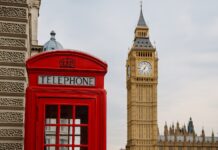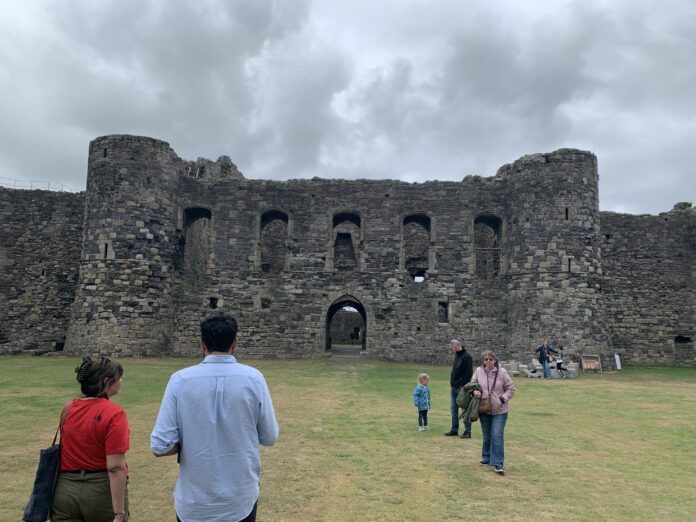Beaumaris Castle is located in the town of Beaumaris on the Isle of Anglesey in Wales. It sits on the Menai Strait across from the mainland town of Bangor. The site has a rich history dating back to prehistoric times. The area has been inhabited since at least 4000 BC. In the 13th century, King Edward I of England began constructing the stone castle as part of his campaign to conquer Wales under his scheme of castles known as the “Ring of Steel.” When completed, it was considered the most advanced design of concentric castles and featured a series of concentric curtain walls and a large central keep.
Though never fully completed, Beaumaris Castle offers tourists a glimpse into medieval castle life. Visitors can explore the ramparts and chambers. Signage describes the ongoing restoration works. Managed by Cadw, a Welsh heritage organization, Beaumaris Castle remains a historic landmark that draws history and architecture enthusiasts to experience its strategic coastal location and picturesque setting along the Menai Strait.
History of Beaumaris Castle
Beaumaris Castle is an old stone fortress in Wales, built long ago by King Edward I. He wanted to control the land and keep an eye on rebellious locals. Construction began in 1295, but the castle was never fully finished. It’s known for its clever design, with a moat and walls to keep enemies out.
Over time, the castle became less important for battles and more like a home for important people. It faced attacks and changes, but it remains a reminder of the past. Tourists now visit to learn about its history and imagine what life was like back then.
Beaumaris Castle is also special because of its connection to history. It’s part of a group of castles built by King Edward I in Wales. These castles tell a story about power, control, and conflicts from long ago. Even though it’s not finished, Beaumaris Castle is a fascinating piece of history that shows how people in the past defended themselves and lived in castles.
History Facts of Beaumaris Castle
- 1295 King Edward I of England started building Beaumaris Castle in Wales. He wanted to show his power and control over the land.
- By 1298, the walls and towers were starting to take shape. The castle’s unique design included four round towers at the corners and a wide moat around it.
- 1301 the construction slowed down due to a lack of money and other challenges. The castle wasn’t finished, but it was already an impressive fortress. The construction was halted multiple times due to financial constraints and shifting priorities.
- Around 1310, more work was done on the walls and the gateways. The castle was almost complete, but some parts were still missing. The walls of Beaumaris Castle are incredibly thick, making them difficult to breach.
- In 1400s, the castle saw some fighting during a rebellion in Wales. Both sides used it as a base, showing its importance in battles.
- In the 1600s, Beaumaris Castle wasn’t used for battles anymore. It became more like a home for important people, but it started to decay over time.
- By the 1800s, people realized the castle’s historical value. Efforts were made to preserve and protect it.
- In the 21st century, the castle is a popular tourist attraction. People visit to learn about its history and explore its unique design.
Beaumaris Castle’s story is a tale of power, conflicts, and changing times. Even though it was never finished, it is a reminder of the past and the people who lived long ago.
51 Interesting Facts About Beaumaris Castle, Anglesey Wales
Here are 51 interesting facts about Beaumaris Castle in detail:
- Beaumaris Castle is located in Beaumaris, Anglesey, Wales. King Edward I built it as part of his ring of castles around the coast of North Wales.
- Construction on the castle began in 1295, but it was never fully completed. The castle was still unfinished when King Edward I died in 1307.
- The castle was designed by James of St. George, the master architect behind many of King Edward’s castles in Wales. The castle’s symmetry and use of concentric walls were ahead of its time in terms of defensive architecture. Beaumaris Castle’s architecture is a fusion of medieval and Romanesque styles.
- Beaumaris Castle was built on a marshy flat land with no natural defensive features. This allowed it to have symmetrical walls and defenses, giving it a very geometric design.
- It was the last and largest of King Edward I’s castles in North Wales. The castle covers around 5 acres of land. Beaumaris Castle is one of the “Edwardian Castles” built by Edward I in Wales.
- Its inner ward is divided into northern, central and southern parts. The central part held the main living quarters and great hall. It was strategically positioned to control the Menai Strait and suppress Welsh uprisings. The Menai Strait, near the castle is situated, was an important waterway for trade and transportation.
- The castle exterior has two lines of fortifications with towers and gatehouses. There is an inner curtain wall and an outer curtain wall. Some outer walls have arrow slits and holes for archers to repel attackers.
- The inner curtain wall has twelve towers spaced at intervals around it. They project outward to allow overlapping fields of fire.
- The outer curtain wall has six larger towers and two gatehouses, the Gate Next Sea and the Llanfaes Gate.
- To protect the main gate, the Llanfaes Gate has an impressive barbican consisting of several towered defences.
- The walls and towers vary in thickness from 7 feet to 15 feet to withstand bombardment.
- Beaumaris was designed to shoot arrows from any tower at attackers near any part of the walls.
- It is considered a textbook example of concentric castle design with multi-layered defences.
- In the 14th century, the English poet William Langland described Beaumaris as the “fairest castle under the fold of heaven.”
- In 1403, the castle was captured by Welsh forces led by Owain Glyndŵr, who held it for two years during his rebellion against English rule. Owain Glyndŵr’s rebellion in the early 15th century caused some damage to the castle.
- Beaumaris Castle became the crown’s property after the English Civil War in the mid-17th century. During the English Civil War, the castle was captured by Parliamentarian forces and later slighted to prevent its use.
- The term “beau marais” translates to “beautiful marsh” in French, possibly alluding to the castle’s moat and surroundings.
- By the 18th century, Beaumaris Castle had fallen into disrepair and started deteriorating.
- The British government began repairing and stabilizing the castle ruins in the 1920s to preserve the historic site.
- In 1925, Beaumaris was designated a Grade I listed building, marking it as a structure of exceptional historical interest.
- Today the castle is cared for by Cadw, the Welsh government’s historic environment service.
- In the summer, costumed interpreters bring the castle to life and explain its history to visitors.
- The castle grounds also comprise a large colony of black-headed gulls, which nest there yearly.
- In 1400, King Henry IV made Beaumaris a county corporate, granting county administrative powers.
- Beaumaris Castle was used as a filming location for Willow, starring Val Kilmer.
- Parts of the Doctor Who episode “The Girl Who Died” were filmed inside the castle.
- The castle appears on the regional coat of arms of Gwynedd County.
- Beaumaris hosted the 2019 Eisteddfod Genedlaethol, an annual festival celebrating Welsh culture and arts.
- The moat around the castle would have been filled with seawater when it was first built. A water-filled moat surrounds the castle, adding an extra layer of defence.
- Archaeologists found a medieval toilet chute built into the castle walls near a latrine tower.
- Its popular museum displays artefacts discovered during excavations, like skeleton keys, coins, pottery shards, and musket balls.
- In 1648, orders were sent to deliberately slight or partially demolish Beaumaris Castle after the English Civil War.
- The northwest tower of the inner ward collapsed in 1839, and the fallen stones were reused in other local buildings.
- In the 1920s, the British warship HMS Rodney was anchored in Beaumaris Bay and used the castle for target practice.
- The stonework on the Llanfaes Gate perfectly matches the one on the opposite side of the Gate Next Sea.
- The castle exterior has over 300 arrow loops and gun ports for firing weapons at attackers.
- It was common for the garrison of soldiers stationed at Beaumaris not to get paid for months or even years.
- The people of Beaumaris hold a pageant at the castle every five years, celebrating the town’s history.
- Historians believe if completed, Beaumaris would have been larger than Conwy Castle.
- The Nazi propaganda minister Joseph Goebbels had a photo of Beaumaris Castle hanging in his office.
- King Edward I ordered the removal of all roofs at Beaumaris Castle so it could not shelter Welsh rebels.
- Owain Glyndŵr’s forces only captured the castle in 1403 after bribing the constable to surrender it.
- The concentric castle design was intended to let the defenders withstand a long siege.
- Beaumaris is derived from the French “beaux marais” meaning “beautiful marshes.”
- The castle appears in the first part of Shakespeare’s Henry IV as the setting for a comedic scene.
- Its symmetrical design and green lawns have led to Beaumaris being described as the prettiest castle in Britain.
- The walls are up to 6 meters thick at some points and up to 10 meters high.
- It was built at the farthest northwest corner of Wales to guard against seaborne invasion.
- The castle had two moats, an inner tidal moat and an outer freshwater moat.
- The castle grounds provided grazing land for cattle, horses, and other livestock needed to support the garrison.
- Beaumaris was still unfinished when James of St. George died around 1309.
- If it had been completed as originally designed, Beaumaris would have been the largest and most perfect example of concentric castle design.
- The castle had a chapel dedicated to St. Mary and a great hall for feasting.
- Beaumaris Castle, along with Conwy, Caernarfon, and Harlech Castles, is a UNESCO World Heritage Site.
- The castle’s dungeons were used to hold prisoners, often in harsh conditions. Many legends and stories are associated with Beaumaris Castle, adding to its mystique. Despite its impressive architecture, Beaumaris Castle was never used as a royal residence. Beaumaris Castle’s historical significance goes beyond its military role, encompassing social and architectural aspects. Beaumaris Castle remains an iconic symbol of medieval Welsh history and architectural innovation.
Today, the castle is a popular tourist attraction managed by Cadw, the historic environment service of the Welsh Government. Beaumaris Castle is a testament to the ambitions and challenges of its time. King Edward I envisioned a grand fortress to assert control over Wales, and this unique stronghold was built in 1295. The castle’s gradual construction and distinctive design, with round towers and a protective moat, showcase architectural ingenuity. However, financial constraints and changing priorities meant the castle remained incomplete yet still imposing.
Over the centuries, Beaumaris Castle transitioned from a strategic military post to a dignitary residence. It endured the tests of rebellion and conflict, demonstrating its role in shaping Welsh history. The castle’s significance shifted from defence to historical preservation as time evolved. In the 1800s, preservation efforts were initiated to ensure that the castle’s story would continue to be told.
Today, Beaumaris Castle is a captivating heritage site, attracting visitors seeking to understand its intricate history. Its incomplete state serves as a poignant reminder of the challenges faced by those who built and defended it. The castle’s journey from a symbol of power struggles to a cherished historical relic illustrates the passage of time and the evolution of priorities. Beaumaris Castle’s legacy persists, inviting us to reflect on the past, appreciate architectural marvels, and learn from the stories embedded within its walls. You can also learn more facts about Anglesey
Opening times
1 March – 30 June
Daily 9.30am–5pm
Last admission 30 minutes before closing
1 July – 31 August
Daily 9.30am–6pm
Last admission 30 minutes before closing
1 September – 31 October
Daily 9.30am–5pm
Last admission 30 minutes before closing
1 November – 28 February
Daily 10am–4pm
Closed 24, 25, 26 December and 1 January
Last admission 30 minutes before closing
Contact
Telephone 03000 252239
Email
[email protected]
Address
Beaumaris Castle
Castle St, Beaumaris LL58 8AP
























